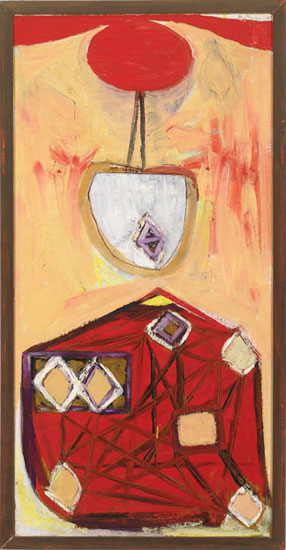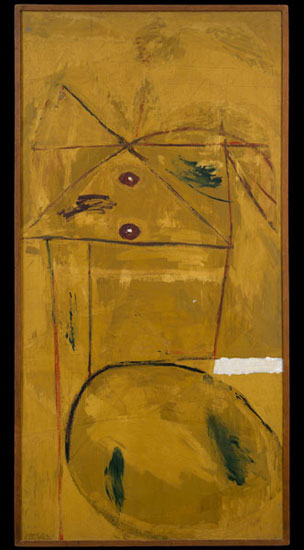It's likely you've never seen wedding portraits such as this. While not intended as paintings replacing traditional wedding photography, two portraits by Robert Motherwell seem to fit the bill as images to mark the moment. Or, maybe, to help mark a marriage.
The Red Skirt is a portrait of Motherwell's first wife, Maria Emilia Ferreira y Moyers. The pair married in August 1942 and the portrait was painted later on, in 1945, while Motherwell lived and worked in East Hampton, N.Y. The couple separated during in 1948 and divorced a year later, according to author, art critic and curator Phyllis Tuchman.
Motherwell painted The Homely Protestant in 1948 and later identified the work as a self-portrait, according to Tuchman. Despite the stretch of years between the paintings, Tuchman coupled the two works as emotionally related and installed the pair side-by-side in "Robert Motherwell: The East Hampton Years, 1944-1952" exhibited at Guild Hall Museum in East Hampton, N.Y. (On view from Aug. 9 to Oct. 13, 2014).
"The Red Skirt and The Homely Protestant are as close as any American abstractionist ever came to painting wedding portraits," wrote Tuchman for The Red Skirt's wall panel in the Guild Hall exhibition. "Having studied Florentine Painting of the Renaissance with Millard Meiss as well as Dutch and Flemish Painting of the 17th Century with Julius Held as a graduate student at Columbia University, Motherwell was familiar with this genre. However, he tweaked his subjects with a contemporary twist. ...Had the artist not acknowledged that The Red Skirt is a portrait of his wife Maria Emilia Ferreira y Moyers, a Mexican actress and budding writer whom he married in August 1942, and The Homely Protestant, a tall ochre painting nearby, a self-portrait, viewers would be hard pressed to identify these abstract personages as real people."
.

"The Red Skirt" by Robert Motherwell, 1947. From the Series, Personages. Oil on composition board, 48 x 24 inches. Whitney Museum of American Art, New York. ©VAGA, NY.
.
Tuchman pointed out that details in The Red Skirt reveal Maria Emilia Ferreira y Moyers's identity as the portrait's subject. These include the skirt conjuring those worn by the painter Frida Kahlo, wrote Tuchman, and a "stereotypical hotheaded Latin spirit about the figure’s face".
Motherwell painted The Homely Protestant after World War II as part of a series of semi-abstract single figure panels. There were around eight and were not well known, according to Tuchman. The Homely Protestant was the only one from the group that achieved recognition in retrospectives, Tuchman wrote in an exhibition wall panel about the painting.
"It [The Homely Protestant] was a particular favorite of his, and hung for many years in the living room of the East 94th Street townhouse he shared with Helen Frankenthaler, his third wife," wrote Tuchman. "Motherwell often suggested that this painting, which once was owned by the Museum of Modern Art, was a self-portrait....Reflecting on the title, which he randomly chose from a passage in James Joyce’s "Finnegans Wake", he admitted in 1965 that the homely protestant “was probably myself. As all one’s painting is.”
Tuchman continues: "The work is ungainly. Rather than crisp, well-defined geometric forms, Motherwell introduced an out-of-kilter triangle for a torso as well as exaggeratedly tall vertical lines for legs. And, during a period when abstractions tended to have smooth surfaces, this one features thick, unevenly applied paint."
The contradictions found in the painting emphasis the work's connection to the painter as a self-portrait, according to Tuchman. In the exhibition panel, she wrote:
"But, almost twenty years later, the older artist additionally explained, “…it was partly a title perversely ironic…Only later did I learn that in “English” “homely” means “homebody,” which also happens to be true of me…But at the time I named it I was referring to the American idiomatic use of being “not beautiful,” not attractive…which I felt more about the picture than myself.”
"Distancing himself further from the word homely, he continued, “I was also, if I may say so, extremely handsome when I was in my twenties, and at the time I named The Homely Protestant, still was…”
.

"The Homely Protestant" by Robert Motherwell, 1948. Oil and tempera on composition board, 97 3/4 x 48 1/4. Lent by The Metropolitan Museum of Art, Gift of the artist. ©VAGA, NY.
.
Mirroring Motherwell and Maria Emilia Ferreira y Moyers's life, The Red Skirt and The Homely Protestant are parted. The Red Skirt is held in the collection of the The Whitney Museum of American Art. The Homely Protestant is part of The Metropolitan Museum of Art's collection. Both museums are located in New York City.
BASIC FACTS: The Red Skirt and The Homely Protestant are exhibited in "Robert Motherwell: The East Hampton Years, 1944-1952" at Guild Hall Museum from Aug. 9 to Oct. 13, 2014. Guild Hall is located at 158 Main Street, East Hampton, NY 11937. www.guildhall.org.
Phyllis Tuchman is an art critic, curator and author. Her book "Robert Motherwell: The East Hampton Years, 1944-1952" (120 Pages, Officina Librania, Sept 2014) was released to coincide with the Guild Hall exhibition which she guest curated.
